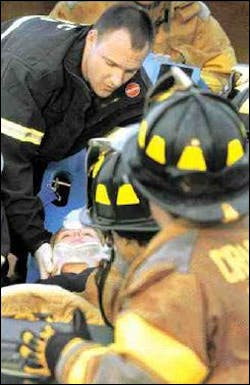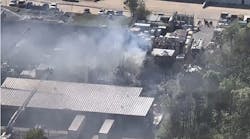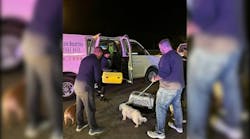The Elsmere Fire Company has teamed with fire departments in nearby Cranston Heights and Belvedere to rotate overnight shifts. They take turns stamping out fires in all three areas.
The arrangement, which started in May, is designed to help volunteer fire departments cope with fewer firefighters. And in this instance, it also serves as an incentive for volunteers to join one of the departments because there is more action and the hours are fixed.
A steady decline in volunteer firefighters is a national trend that started 20 years ago, with ranks thinning from 880,000 to 790,000 nationwide, or about 10 percent, according to the International Association of Fire Chiefs.
"I don't think it's as strong of a community commitment as it was when I first joined," said Andy Hall, chief of the Townsend Fire Company and a volunteer for almost 24 years. "We want to take you away from your family and work you hard and basically not give you any money for it."
Firefighter Joe Vannucci of the Good Will Fire Company of New Castle has volunteered for 30 years and is ready for a break, but said he won't be taking one anytime soon.
"I do it because there's no one else doing it," he said. "After this many years, you should be slacking off, but you need to be picking up the pace. We can't seem to draw the volunteers like we used to."
Odd hours, no pay
In Delaware, 60 volunteer fire departments rely on members to drop whatever they are doing and respond mostly by pager to emergencies. Wilmington firefighters are paid and work regular shifts.
Most of the volunteers work elsewhere. But when the alarm rings, everyone available - from the chief on down - climbs aboard the firetrucks and sometimes put their lives on the line for the community. In addition to a small state pension, they get a uniform, equipment and training, the use of recreational facilities at the firehouse, a $400 state tax credit and free annual picnics and banquets, said Hall, who works in the maintenance department at an automobile assembly plant.
But for fighting those fires, they get no pay.
The service saved taxpayers more than $140 million last year, according to state Auditor Tom Wagner, whose office compiles an annual financial report on the volunteer fire departments.
The fire departments are supported by state grants, money from a fraction of fire insurance taxes assessed each year, fund-raisers and contributions, said Jim Cubbage, executive secretary of the Delaware Volunteer Firemen's Association.
They serve for free because it's how fire departments started, Cubbage said. "I think it's neighbor taking care of neighbor," he said. "The same mission is still there, to be able to help their neighbors in time of emergencies."
Changes in society are making that tradition more difficult, and they account for some of the drop in the number of volunteer firefighters.
"I think the biggest single thing is our lives have become so busy. We're go, go, go, go, go, go, go," said Michael Kernan, director of the Delaware State Fire School in Dover. "Everybody's working multiple jobs. They're juggling children and everything else."
Townsend firefighter Bob Bartley can attest to that. He has been with Townsend one year, and served six years at the Christiana Fire Company, from 1976 to 1982.
"I had a few years in between the fire companies because of kids, because of family life," Bartley said. "Family comes first. That's just what I had to do."
Emergency calls on rise
As the number of volunteers has dropped, the number of ambulance and fire calls has increased, which makes efforts to attract more volunteers even more critical, firefighters said. Firefighters also are trained as emergency medical technicians.
Fire department calls in New Castle County climbed from about 36,000 in 1994 to about 54,500 last year. In the same period, calls in Kent County rose from about 15,000 to 23,500, and Sussex County went from about 13,500 to 21,000, according to the three county dispatch centers.
New housing developments and rising populations are among the reasons for the increases, said Dave Roberts, emergency services assistant manager of communications for New Castle County.
To meet the demand, some volunteer fire departments are hiring paid supplemental firefighters, full-time members who work primarily as emergency medical technicians but also are trained to put out fires. The Lewes Fire Company, for example, added two paid firefighters three years ago, increasing its full-time paid staff to six, Chief Gordon Davis said.
But the paid firefighters at the volunteer departments are only a fraction of the 4,000 volunteers statewide.
Almost all of the 21 volunteer fire departments in New Castle County have hired supplemental crews, said Tom Mitten, spokesman for the New Castle County Volunteer Firemen's Association. Paid members at the volunteer fire departments provide guaranteed staffing for emergency medical services, which make up most 911 calls. Sussex County had about 16,500 ambulance runs last year, for instance, compared with about 4,500 fire calls, said Joe Thomas, director of the county's emergency operations center.
Training requirements make recruitment tough, too.
Fire School Administrator Jerry Brennan said firefighting is more technical and specialized, and now includes learning about hazardous materials, self-contained breathing apparatus and situational emergencies such as confined-space and high-angle rescues. It takes about 200 hours to become a certified firefighter, he said, compared with six to eight hours of training 30 years ago.
"Times have changed," he said. "You don't just go to the fire department now and hang around. If you go up there now, you're doing some training, and that's no fun. That's why some of the volunteers drop out the way they do."
Bartley, the Townsend firefighter who is a self-employed diesel mechanic, completed 200 hours of training in the past year, mostly on weekends. "And a lot of fire companies want you to go to meetings. There's a whole lot more than just going to fires," he said.
Combining forces
Mitten, who also is a spokesman for the Elsmere Fire Company, said its arrangement with the other fire departments is a good way to help counter the decline in volunteers and could be a wave of the future.
Crews of at least four firefighters work shifts from 10 p.m. to 6 a.m., with in-house sleeping accommodations much like the paid firefighters in Wilmington, he said. Not only does the partnership of the three fire departments make use of a smaller number of firefighters to cover a larger area, it is popular because firefighters know well in advance when they will be needed.
"What this does is it sets time off for them. They can work around it," Cranston Heights Chief George Lamborn said. "I think it's great. It's brought interest back into the fire service for the members. It gives the opportunity to get the different runs, get more experience."
The Lewes fire department has relaxed its requirement that each member respond to one-third of its total fire calls each year, Davis said. About five years ago, the department began awarding points for going to fire calls, training and work details. Firefighters must maintain 100 points each year.
That tactic, and other recruitment measures such as working closely with Cape Henlopen High School in Lewes to attract junior firefighters, has helped double the fire department's rolls to about 100 active volunteers, including 20 junior members, Davis said. The junior firefighters are not allowed to go into burning buildings or perform other dangerous tasks, Mitten said.
A scholarship funded by the federal government and New Castle County also helps bring in young members.
Hall said firefighters such as himself are a rare breed.
"They have the bug," he said. "That's a person who is committed to do the job because they love what they do and they love doing it. It's a pride. You feel good about what you're doing. I have a very strong passion for this. It makes me feel very proud to be able to give back to the community."






